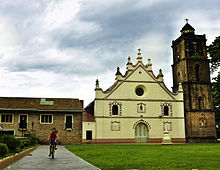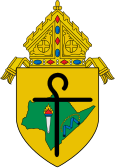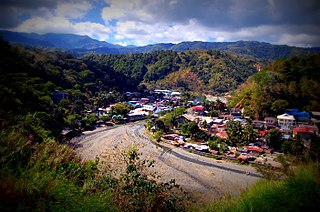
Nueva Vizcaya, officially the Province of Nueva Vizcaya, is a landlocked province in the Philippines located in the Cagayan Valley region in Luzon. Its capital and largest town is Bayombong. It is bordered by Benguet to the west, Ifugao to the north, Isabela to the northeast, Quirino to the east, Aurora to the southeast, Nueva Ecija to the south, and Pangasinan to the southwest. Quirino province was created from Nueva Vizcaya in 1966.

Dupax del Norte, officially the Municipality of Dupax del Norte, is a 3rd class municipality in the province of Nueva Vizcaya, Philippines. According to the 2020 census, it has a population of 33,295 people. Dupax del Norte, situated on the south-eastern part of Nueva Vizcaya, has a total land area of 396 square kilometers. It is bounded by the town of Kasibu in the north, Alfonso Castañeda in the east, Dupax del Sur in the south, and Bambang in the west. It has wide tracts of virgin forests, rich, fertile plains and valleys with mineral deposits and has a climate suitable for agriculture.

The CICM Missionaries, officially known as the Congregation of the Immaculate Heart of Mary and often abbreviated as C.I.C.M, is a Catholic clerical religious congregation of Pontifical Right for men established in 1862 by the Belgian Catholic priest Theophile Verbist (1823–1868). Its members add the post-nominal letters C.I.C.M. to their names to indicate membership in the congregation.

Alfonso Castañeda, officially the Municipality of Alfonso Castañeda, is a 1st class municipality in the province of Nueva Vizcaya, Philippines. According to the 2020 census, it has a population of 8,539 people, making it the least populated municipality in the province.

Bayombong, officially the Municipality of Bayombong, is a 1st class municipality and capital of the province of Nueva Vizcaya, Philippines. According to the 2020 census, it has a population of 67,714 people.
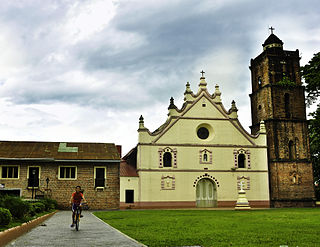
Dupax del Sur, officially the Municipality of Dupax del Sur, is a 2nd class municipality in the province of Nueva Vizcaya, Philippines. At the 2020 census, it had a population of 21,224 people.

Solano, officially the Municipality of Solano, is a 1st class municipality in the province of Nueva Vizcaya, Philippines. According to the 2020 census, it has a population of 65,287 inhabitants..
Dupax, officially the Municipality of Dupax, was a municipality in the province of Nueva Vizcaya, Philippines. Founded during the Spanish era, it was divided into Dupax del Norte and Dupax del Sur in 1971.

Bagabag Airport is an airport serving the general area of Bagabag, located in the province of Nueva Vizcaya in the Philippines. It is the only airport in Nueva Vizcaya and is classified as a community airport by the Civil Aviation Authority of the Philippines, a body of the Department of Transportation that is responsible for the operations of airports in the Philippines except the major international airports.
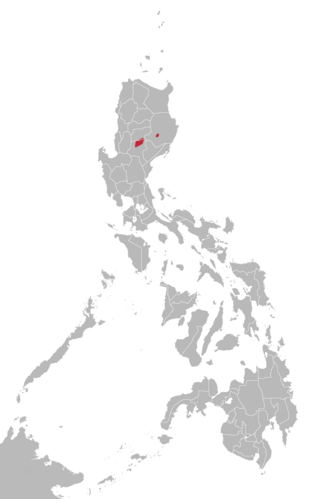
The Gaddang language is spoken by up to 30,000 speakers in the Philippines, particularly along the Magat and upper Cagayan rivers in the Region II provinces of Nueva Vizcaya and Isabela and by overseas migrants to countries in Asia, Australia, Canada, Europe, in the Middle East, United Kingdom and the United States. Most Gaddang speakers also speak Ilocano, the lingua franca of Northern Luzon, as well as Tagalog and English. Gaddang is associated with the "Christianized Gaddang" people, and is closely related to the highland tongues of Ga'dang with 6,000 speakers, Yogad, Cagayan Agta with less than 1,000 and Atta with 2,000, and more distantly to Ibanag, Itawis, Isneg and Malaweg.

The Roman Catholic Archdiocese of Tuguegarao is a Latin Church metropolitan archdiocese of the Catholic Church in the Philippines. Tuguegarao is a river delta city that became center of the archdiocese in the province of Cagayan, on the island of Luzon. Its seat is located at the Saint Peter the Apostle Metropolitan Cathedral.

The University of Saint Louis Tuguegarao is a private Catholic higher education institution run by the Congregation of the Immaculate Heart of Mary in Tuguegarao City, Cagayan, Philippines. It was founded in 1965 by the CICM Missionaries. It traces its roots from a diocesan secondary school named Cagayan Valley Atheneum established in 1938 by Msgr. Constant Jurgens, C.I.C.M., D.D., a Dutch by nationality, then Bishop of the Diocese of Tuguegarao and a CICM missionary and great educator. The CICM Fathers took over administration of the school in 1965 and renamed.

Saint Vincent Ferrer Parish Church, commonly known as Sabtang Church, is a Roman Catholic church located near Sabtang Port in Sabtang, Batanes, Philippines. It is under the jurisdiction of the Territorial Prelature of Batanes. Originally a small chapel in 1785 when the Sabtang mission first opened by the Dominicans, the church underwent few modifications until 1984. A short distance to the right of the church's façade stands a pedestal with a stone statue of Saint Vincent Ferrer, the patron saint of the parish and of the municipality.
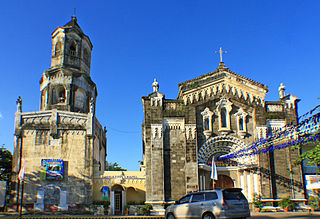
The Diocesan Shrine and Parish of Nuestra Señora de la Asuncion, commonly known as Bulakan Church, is a 19th-century Neo-Byzantine-Romanesque stone church located at Brgy. San Jose, in the Municipality of Bulakan, Bulacan province, Philippines. It is one of the parishes of the Roman Catholic Diocese of Malolos under the Vicariate of the Immaculate Conception. The church was declared Marked Historical Structure of the Philippines in 2007 by the National Historical Institute, the precursor of the National Historical Commission of the Philippines. A historical marker bearing a brief history of the church was installed by the commission.

Saint Peter Metropolitan Cathedral, commonly known as Tuguegarao Cathedral, is an 18th-century Baroque Roman Catholic church located along Rizal Street, Barangay Centro 10, Tuguegarao, Cagayan, Philippines. The church, originally built by Dominican friars, is the seat of the Archdiocese of Tuguegarao and is considered one of the largest churches in the Cagayan Valley. A historical marker bearing a brief history of the church was installed in 1982 by the National Historical Institute, precursor of the National Historical Commission of the Philippines.

Saint Raymond of Peñafort Parish Church, commonly known as Malaueg Church or Rizal Church, is an early 17th-century Baroque Roman Catholic church located at Brgy. Poblacion, Rizal, Cagayan, Philippines. The parish church, with Saint Raymond of Peñafort as its titular patron, is under the jurisdiction of the Archdiocese of Tuguegarao. The church structure has been declared a National Cultural Treasure by the National Museum of the Philippines in 2001. A marker, bearing a brief history of the church, was installed on the church's facade by the National Historical Commission of the Philippines.
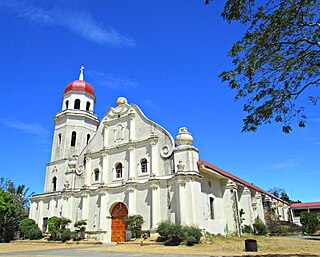
Saint Catherine of Alexandria Parish Church, commonly known as Tayum Church, is a 19th-century Baroque Roman Catholic church located at Brgy. Poblacion, Tayum, Abra, Philippines. The parish church, under the patronage of Saint Catherine of Alexandria, is under the jurisdiction of the Diocese of Bangued. The church, together with 25 other Spanish-era churches, was declared a National Cultural Treasure by the National Museum of the Philippines in 2001. Its current parish priest is Fr. Roderick Ardaniel, who succeeded Fr. Ruben Valdez.

Saint Dominic de Guzman Cathedral, commonly known as Bayombong Cathedral, is an 18th-century, Baroque Roman Catholic church located at Brgy. Salvacion, Bayombong, Nueva Vizcaya, Philippines. The cathedral, which is the seat of the Diocese of Bayombong, is under the patronage of Saint Dominic and was originally founded in 1739 by the Augustinian Friars of Spain.

Saint Catherine of Siena Parish Church, commonly known as Bambang Church, is an 18th-century, Baroque Roman Catholic church located at Brgy. Buag, Bambang, Nueva Vizcaya, Philippines. The parish church, dedicated to Saint Catherine of Siena, is under the jurisdiction of the Diocese of Bayombong.

Carlos Mapili Padilla was a Filipino politician who served as the Governor of Nueva Vizcaya from 2016 until his death in 2023. Padilla was elected to his first term as Governor in 2016 and was re-elected in 2019 and 2022.
